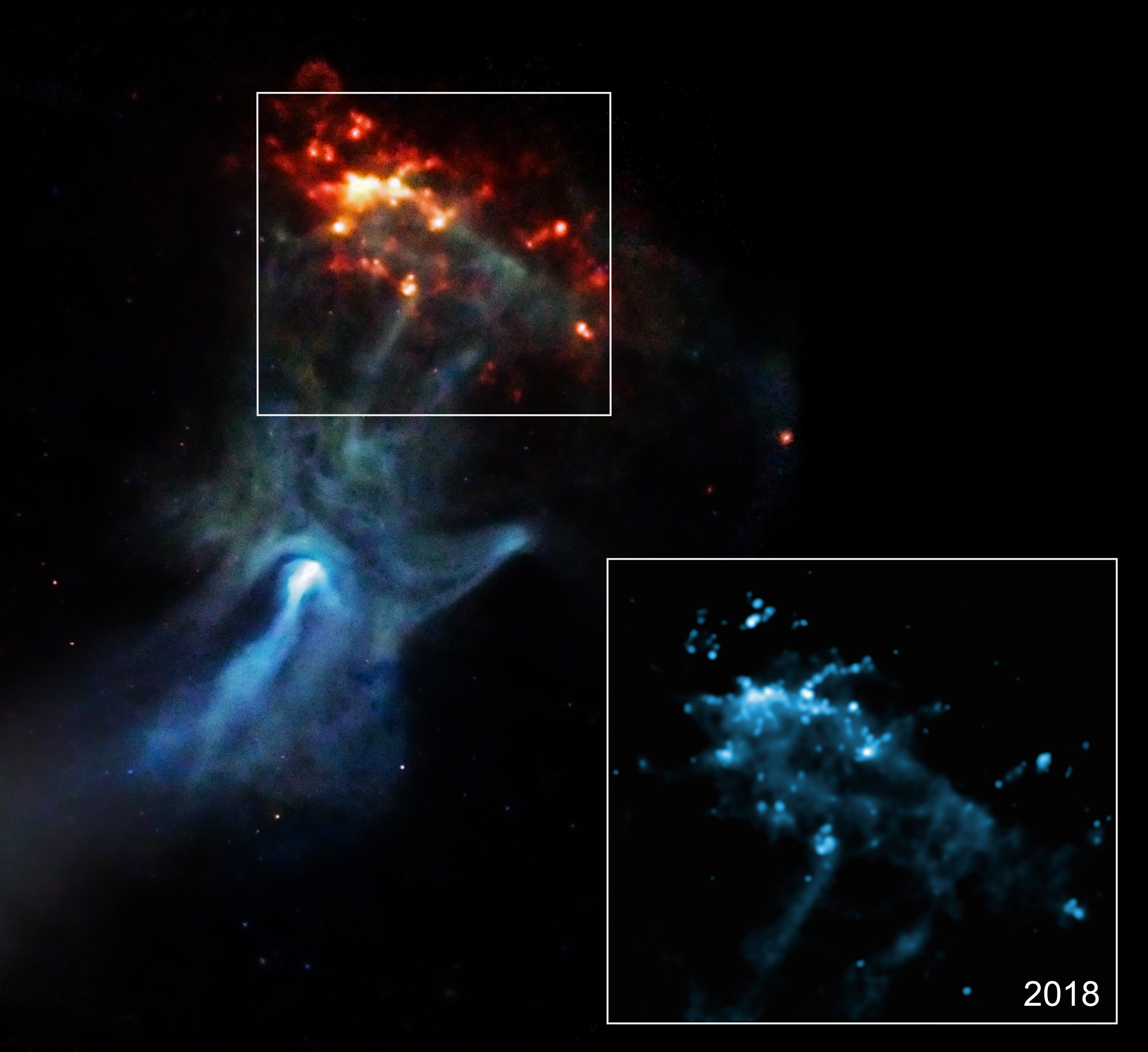Once again, NASA’s Chandra X-Ray Observatory has gifted us with some of the most breathtaking images known to humankind. The images are as groundbreaking as they are beautiful: what you’re looking at marks the first time ever that the motion of an exploded supernova has been measured by humans.
Using data from 2004, 2008, and a combined image from 2017 and 2018, astronomers have revealed a picture of a vast, ghostly hand moving through space to hit a wall of red cosmic gas.

Using data from 2004, 2008, and a combined image from 2017 and 2018, astronomers have revealed a picture of a vast, ghostly hand moving through space to hit a wall of red cosmic gas.

Oooh, pretty! Image credit: NASA/SAO/NCSU/Borkowski et al.
The images show the motion of the blast wave around the tip of one of the “fingertips” – a blast wave that is moving through space at around 14.5 million kilometers per hour (9 million miles per hour). Some of the remnants of the star, left behind as cosmic debris when it went supernova, are moving even faster, at over 17.7 million km/h (11 million mph).

The fingertips move through the cosmos. Image credit: NASA/SAO/NCSU/Borkowski et al., IFLS
Mind-bogglingly fast though this is, the ghostly hand – whose given name is MSH 15-52 – has actually experienced a dramatic deceleration, according to a paper published in The Astrophysical Journal Letters by the Chandra team. That’s most likely thanks to RCW 89, the gas cloud it is colliding with. According to the team, the cosmic debris must have first traveled through a low-density cavity of gas, which was formed when the star shed its outer layer of hydrogen before exploding, then slowed down dramatically when it hit RCW 89.
The researchers estimate the “hand” must have traveled on average at nearly 50 million km/h (30 million mph). That’s an average, not a maximum.
Light from the supernova first reached Earth around 1,700 years ago, the researchers estimate – a time when the Mayan empire was flourishing, Rome was just starting to turn Christian, and India was inventing a fancy new type of math called trigonometry. But by cosmic standards, MSH 15-52 is a baby. In fact, it's one of the youngest supernova remnants in the Milky Way.
When the star exploded, it left behind a super dense pulsar. This pulsar – the collapsed core of a massive star, which spins rapidly and spews energy out into space – is what has created the eerie hand. It is spinning at almost seven revolutions per second and releasing a quite remarkable amount of energy into the cosmos around it.
The pulsar’s incredible rate of energy release is likely because it has an intense magnetic field at its surface, thought to be 15 trillion times stronger than Earth's magnetic field, according to astronomers when a photo of the MSH 15-52 nebula was released back in 2009.
The pulsar's rapid spin and strong magnetic field make it one of the most powerful electromagnetic generators in the Milky Way, creating a blast wave that formed the iconic hand-shaped nebula seen by Chandra.
The images show the motion of the blast wave around the tip of one of the “fingertips” – a blast wave that is moving through space at around 14.5 million kilometers per hour (9 million miles per hour). Some of the remnants of the star, left behind as cosmic debris when it went supernova, are moving even faster, at over 17.7 million km/h (11 million mph).

The fingertips move through the cosmos. Image credit: NASA/SAO/NCSU/Borkowski et al., IFLS
Mind-bogglingly fast though this is, the ghostly hand – whose given name is MSH 15-52 – has actually experienced a dramatic deceleration, according to a paper published in The Astrophysical Journal Letters by the Chandra team. That’s most likely thanks to RCW 89, the gas cloud it is colliding with. According to the team, the cosmic debris must have first traveled through a low-density cavity of gas, which was formed when the star shed its outer layer of hydrogen before exploding, then slowed down dramatically when it hit RCW 89.
The researchers estimate the “hand” must have traveled on average at nearly 50 million km/h (30 million mph). That’s an average, not a maximum.
Light from the supernova first reached Earth around 1,700 years ago, the researchers estimate – a time when the Mayan empire was flourishing, Rome was just starting to turn Christian, and India was inventing a fancy new type of math called trigonometry. But by cosmic standards, MSH 15-52 is a baby. In fact, it's one of the youngest supernova remnants in the Milky Way.
When the star exploded, it left behind a super dense pulsar. This pulsar – the collapsed core of a massive star, which spins rapidly and spews energy out into space – is what has created the eerie hand. It is spinning at almost seven revolutions per second and releasing a quite remarkable amount of energy into the cosmos around it.
The pulsar’s incredible rate of energy release is likely because it has an intense magnetic field at its surface, thought to be 15 trillion times stronger than Earth's magnetic field, according to astronomers when a photo of the MSH 15-52 nebula was released back in 2009.
The pulsar's rapid spin and strong magnetic field make it one of the most powerful electromagnetic generators in the Milky Way, creating a blast wave that formed the iconic hand-shaped nebula seen by Chandra.


Post a Comment